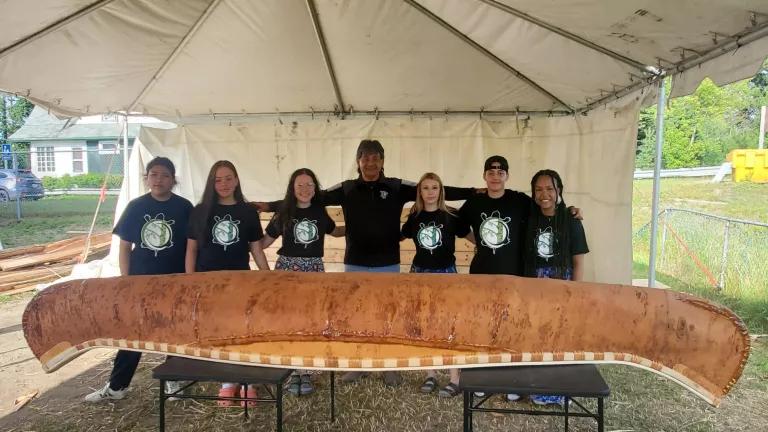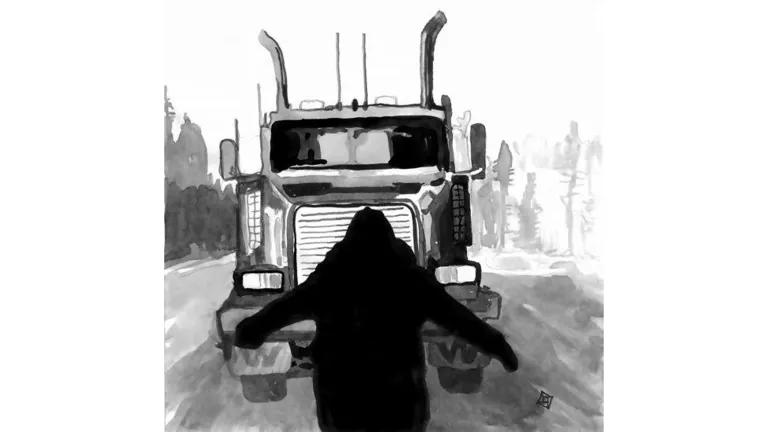Wahkohtowin Development: Creating an Indigenous Conservation Economy
Using a collaborative approach, Chapleau Cree, Missanabie Cree and Brunswick House First Nations are advancing a new paradigm of sustainability.

Wahkohtowin Development communities are supporting cultural revitalization activities, including birch bark canoe building.
Wahkohtowin Development
This blog is co-authored with David Flood, RPF, Registered Status Indian - Band Member at Matachewan First Nation, General Manager at Wahkohtowin Development GP.
As unprecedented wildfires have burned in forests across Canada this year, the need for transformational shifts in forest management could not be more clear. For three First Nations in northeastern Ontario—Chapleau Cree, Missanabie Cree and Brunswick House—the cumulative effects of industrial development on their ancestral lands and urgent need for a new paradigm around land stewardship and Indigenous rights drive their efforts to protect their territories and promote just, sustainable economies.
The three First Nations have been working together to create this new reality through Wahkohtowin Development, a social enterprise focused on building a conservation economy. The word Wahkohtowin (Wah - Koht - Owin) describes a Cree living philosophy that translates to “acknowledging and respecting that everything is connected” in English. Their vision centers relationships with each other and with lands and waters, Indigenous knowledge and language, and protection of fish populations and wildlife habitats, and other areas of cultural and spiritual importance.
Critical to this work is Wahkohtowin’s support of the resurgence of Indigenous and Natural Law. This includes innovating the way forests are managed on their territories using two-eyed seeing—an approach to understanding forest ecosystems and developing solutions that see through an Indigenous lens with one eye, and a Western European lens through the other. It recognizes that both knowledge systems are needed to address the complex problems we now face.

Wahkohtowin (Wah - Koht - Owin) describes a Cree living philosophy that translates to “acknowledging and respecting that everything is connected” in English.
Wahkohtowin Development
Leveraging these knowledge frameworks, Wahkohtowin is pursuing a number of groundbreaking initiatives, including:
- Supporting Indigenous-led conservation efforts to meet the Global Biodiversity Framework commitments,
- Conducting research on how to reduce/eliminate glyphosate (herbicide) spraying following industrial logging,
- Establishing a Forest Guardians youth program to train future forest stewardship leaders,
- Developing programs to support critical housing needs with wood from local forests,
- Engaging with University of Guelph and a Chapleau Cree First Nation Band Member—Elena McCullough—to support research for her Masters degree. She is exploring a Moose Recovery Strategy, including the identification and conservation of late winter moose habitat, and,
- Challenging the province’s approval of forest degradation on the three First Nations’ territories, in violation of their Treaty agreements and Indigenous rights.
Protecting 30% of the lands and waters on their territories by 2030
Wahkohtowin is actively engaged with Canada to achieve the Global Biodiversity Framework goal of 30 percent land conservation by 2030. In addition to identifying important areas in need of protection using both Indigenous and Western knowledge and science, they have been developing a strategic path forward through building partnerships with Indigenous and non-Indigenous organizations, including those in non-extractive economic sectors. The First Nations’ communities are shifting the focus from economic activities that have relied on overexploitation of their lands to inclusive, sustainable conservation projects that benefit their people and their local economy. This approach prioritizes the protection of biodiversity, the reduction of forest degradation, and the maintenance of ecological services, while also promoting income generation and job creation for the long-term.
Reducing/Eliminating Glyphosate-spraying
The Nations are concerned over the human and environmental health impacts from the spraying of glyphosate, a herbicide the logging industry often uses as part of their forest regeneration efforts. These impacts include effects on edible and medicinal plants important to their communities, which then impacts other species that need this vegetation to thrive. Glyphosate sprayed on forests also kills slow-burning trees (e.g., aspen), which can leave forests more vulnerable to wildfire.
With an industry partner, community representatives have been conducting trials of methods that could reduce or eventually replace glyphosate spraying (known as the Herbicide Alternative Program). These new methods are applied even before logging occurs, and include identifying areas where soil and root disturbance should be minimized, which reduces the spread of unwanted plants. The program has also investigated the impact of changing the density and timing of planting, and whether planting larger seedlings could help them compete with other fast-growing species. The Herbicide Alternative Program is also exploring new vegetation management techniques that employ paid workers with brush cutters to remove trees and shrubs mechanically. Their methods have included experimenting with electric powered brush cutters, which are better for the climate and the people using them. This mechanical rather than chemical approach allows for more precise vegetation management, and has the potential to create more employment than herbicide spraying.

The Herbicide Alternative Program is exploring new vegetation management techniques that employ paid workers with brush cutters to remove trees and shrubs mechanically, including experimenting with electric powered brush cutters which are better for workers and the environment.
Wahkohtowin Development
Supporting Forest Guardians and land-based youth mentorship and employment
Wahkohtowin communities acknowledge that their youth are their next leaders and will be critically important in leading the way in solving the biodiversity and climate crises we face. The Guardians program is built upon an elder-guided covenant of relationship—which requires a Guardian to embrace a deep commitment to interconnection as per Natural Law. Through the program, communities are providing opportunities for employment and education for youth that enable them to take leadership roles in developing and implementing nature-based solutions. This land-based learning program helps youth build relationships to their homelands, culture, and Indigenous ways of knowing. By merging the traditional and contemporary ways of understanding the land, the program offers a unique experience for youth seeking to deepen their connection to the natural world and their cultural roots. Youth are engaged in land management discussions and are defining their role within land stewardship, climate action, food sovereignty, and participation in forest management. Their work also includes cultural revitalization projects, such as an annual birch bark canoe building and launch celebration.
Innovating to address critical housing needs
In August 2021, Wahkohtowin opened the doors to its Innovation Centre, a gathering place where the communities can work collaboratively on economic development, conservation, and cultural revitalization initiatives. The Innovation Centre is open to the public, communities, partners, and allies to learn about Wahkohtowin’s vision of forest management, conservation and stewardship and to explore collaborative opportunities.
Wahkohtowin has also launched the Tree to Home program to meet First Nations’ housing needs with locally harvested and processed wood. Through investing in a bankrupt mill in the region, Wahkohtowin has facilitated Indigenous-led and owned economic development that aligns with their forest conservation initiatives. Onebowl.org has been formed as a not-for-profit housing supply chain solution for First Nations to bring the standing trees in their territory to standing homes in their communities. The housing kits built from thermo logs are key to allowing home building alternatives for First Nations.
The Supreme Court of Canada acknowledges the right for First Nation families to shelter themselves with wood/logs from the forest in their territories. This program also becomes part of the pathway to reduce housing costs to remote First Nations and facilitates building more homes with existing financial support.

Wahkohtowin has launched the Tree to Home program to meet First Nations’ housing needs with locally harvested and processed wood.
Wahkohtowin Development
Addressing historical and ongoing forest and ecological degradation
For over a century now, the boreal forest in the three First Nations’ traditional territories have been subjected to extensive degradation from industrial development and forestry activities, authorized by the Government of Ontario without their full participation. The Nations assert that the health of the ecosystem depends on the forest being understood and protected as an interconnected whole. The pace of degradation has been increasing, eroding forest cover, including in late winter moose habitat, and lowering forest resilience. They are also concerned that previous management has made these lands and waters more vulnerable to climate change.
Last year, these Nations announced they are pursuing legal action against the Government of Ontario, stating that forestry operations, in particular, and other industrial activities have impacted their ability to maintain their cultural practices. Chief Corston (Chapleau Cree First Nation) believes that the Government of Ontario is allowing companies to turn the boreal forest into wood fibre farms.
"None of us want to go to court. It's about protection. It's about protecting the land, protecting the water, making sure we all understand that … we have to have industry, but it can't be at any cost."
Chief Keith (Keeter) Corston - Chapleau Cree First Nation
You can listen to Chief Corston and lawyer Amy Westland speak to the degradation of the boreal forest here.
Rather than heeding the First Nations’ concerns, since 2020, Ontario has instead made extensive changes to its environmental and forest management legislation and regulations that reduce protections for the life-sustaining ecosystem. This includes a blanket exemption for forest management planning in Ontario from individual environmental assessments and reduced protections for species at risk. Forestry was previously managed through a Class Environmental Assessment (known as Forest Management Declaration Order - OMNR 75) which required over 100 conditions that the Ontario Ministry of Environment was to review, monitor and evaluate; including the provisions that First Nations and the public could request deeper assessments (known as “bump ups”) where protections were not considered sufficient. This provision no longer exists.
Just prior to the extinguishment of the “bump up” provisions, the three First Nations intervened on the Gordon Cosen Forest Management Plan citing lack of consultation by Ontario and lack of environmental, ecological and habitat considerations to address climate actions and forest resiliency. Since 2020, the Judicial Review has been put in abeyance, and a Customized Consultation Agreement and the Relationship Table Agreement have been in place to explore if and how Ontario is prepared to implement co-existence or co-management environments. Given the global acceptance of the United Nations Declaration on the Rights of Indigenous Peoples and emerging efforts of the Government of Canada, the province will have a major role to play.
How can others help?
Wahkohtowin is an example of an Indigenous-led initiative that is helping to ensure the protection, conservation and management of the globally important carbon, biodiversity and cultural values of the boreal forest. The team at Wahkohtowin is growing, and its Strategic Plan is robust. It is focusing on achieving a conservation economy—a place where the First Nations can continue to live within the natural environment and benefit from environmentally sound economic initiatives in the region.
Wahkohtowin’s model is built on collaboration and it does all of this through the Innovation Center at 40 Pine St, Chapleau, Ontario. The Innovation Center is designed to provide extension services and knowledge transfer. As a social enterprise, Wahkohtowin is always seeking funds to keep the office and programming operating. To learn more, you can go to Wahkohtowin’s website and/or reach out to David Flood, Wahkohtowin's General Manager at wdgpi.gm@wahkohtowin.com. You can also donate—one time, or on a monthly/annual basis—directly through Wahkohtowin’s PayPal here.



